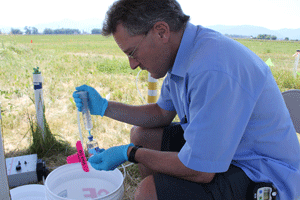 I was privileged to be invited to gain some experience 'in the field' on the annual CO2 release at the ZERT controlled release site, ahead of our Environmental Impacts workshop being hosted there next week by Montana State University. ZERT is a facility hosted by the Montana State University under the direction of Lee Spangler, and consists of a 70m horizontal injection well approximatley 2m under the ground in a meadow. This enables a range of monitoring technquies and impact assessment techniques to be tested along its length, from geochemical and geophysical to biological, from subsurface to atmospheric.
I was privileged to be invited to gain some experience 'in the field' on the annual CO2 release at the ZERT controlled release site, ahead of our Environmental Impacts workshop being hosted there next week by Montana State University. ZERT is a facility hosted by the Montana State University under the direction of Lee Spangler, and consists of a 70m horizontal injection well approximatley 2m under the ground in a meadow. This enables a range of monitoring technquies and impact assessment techniques to be tested along its length, from geochemical and geophysical to biological, from subsurface to atmospheric.
On arrival for my first day today, I found the ZERT site is a nice open meadow with mountain views, warm and sunny, with an impressive range of different monitoring techniques in place. The CO2 injection had started at 6pm on Tuesday, at a rate of 0.15t per day, with intensive background montoring beforehand and then following injection. However, afternoon thunder storms are not uncommon, and yesterday one caused a ljosirtning strike close by. This damaged some of the injection control electronics, so injection had to stop. The team here are hoping for new parts to be delivered within 48 hours.
There is still the injected CO2 in the ground, being dynamic and dispersing, so there is still lots to measure. After a safety briefing from the Site Manager Laura Dobeck I assisted Katherine Romanak from the University of Texas BEG in testing their 'Process-based' soil gas monitoring, which uses the ratio of different soil gases to determine whether the CO2 present is biogenic, methane generated, or introduced (ie leak from storage). This kept me busy on regular gas and water sampling at three different wells, and seeing CO2 in the soil gas (with a gas chromatograph) and in the water in real-time. Most importantly, the soil gas ratios are working out nicely with the CO2 arrival at the wells to show that it is not biogenic, unlike the CO2 present before injection. All here are hoping for the injection control to be repaired and working tomorrow, but more thunderstorms are forecast for the next few days.
12 July 2012. Tim Dixon.
For more info on ZERT http://www.montana.edu/zert/
 Tim Dixon in the field
Tim Dixon in the field
UPDATE
Good news. After tenacious work by Laura Dobeck, the CO2 injection restarted on Sunday evening, just as CO2 was going back towards baseline levels in many places. So the monitoring programme continues, and just in time for the Environmental Impacts Workshop visit on Tuesday.
Tim Dixon. Tues 17 July.


